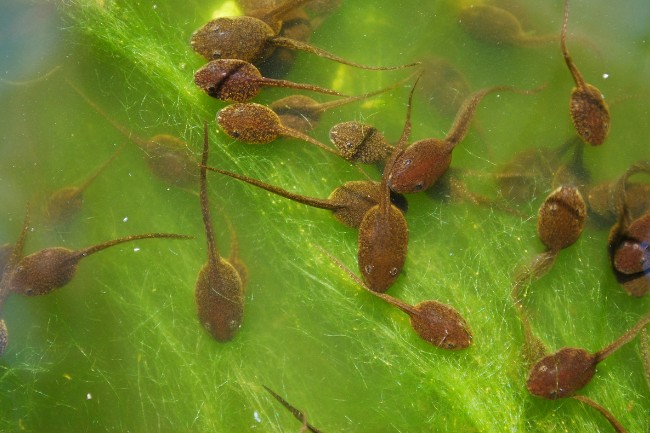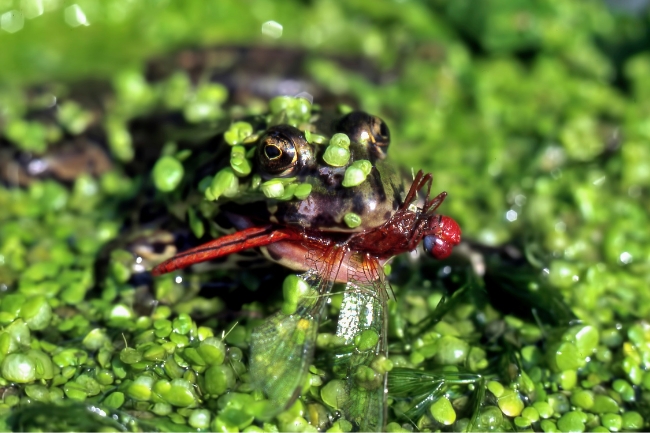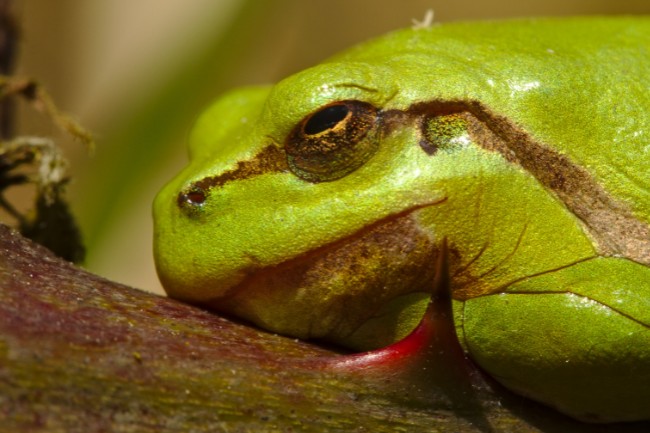Frogs are a type of amphibian and are found across almost every continent. Frogs are well known for their long tongues, bulging eyes, and strong back legs.
When it comes to diet, many of us think of the classic image of a frog sitting on a lily pad, trying to catch flies. Yet, while flies can be an important part of the frog’s diet, different species often specialize in different kinds of food, from fish to mice.
In this article, we discuss the different kinds of foods wild and pet frogs will eat, and how they specialize.
The Natural Diet of Frogs
Frogs come in a range of sizes, from miniature poison dart frogs to huge pacman frogs. Size is an important factor for diet, as frogs don’t chew on their food, meaning they swallow them whole instead. The bigger a frog is, the larger the prey they can eat.
Another important factor for diet is where they live. Although most frogs are semi-aquatic, some frogs are fully aquatic, meaning they spend all their time in the water. Living in the water, these frogs are more likely to encounter fish than flies, meaning this is often what they specialize in.
The final important factor is the physical adaptations of the frog. Taking our aquatic species as an example, many of them have lost the typical long frog tongue, as they can’t use it underwater.
| Frog Species | Prey Items | Additional Information |
|---|---|---|
| Green Frog | Insects (flies, beetles, crickets), spiders | Will also consume small fish, tadpoles, and other small aquatic organisms |
| African Clawed Frog | Aquatic invertebrates (worms, small crustaceans) | Known to eat snails, small fish, and amphibian eggs in addition to invertebrates |
| Red-eyed Tree Frog | Moths, butterflies, beetles, grasshoppers | Has been observed eating small lizards and other tree-dwelling invertebrates |
| Bullfrog | Fish, small mammals, birds, reptiles | Opportunistic feeders that will consume a wide range of prey, including vertebrates |
When it comes to the types of food frogs eat then, the list is surprisingly long. As adults frogs are carnivores, eating other animals. However, during the tadpole stage, most frogs are herbivores or detritivores.
Tadpole foods include;
- Algae
- Leafs
- Decomposing plant matter
- Fish feces
- Decomposing animal matter

Adult frogs’ diets are less varied in the type of food they will eat, but still incredibly wide-ranging when it comes to the different animals they will feed on.
Adult frog foods can include;
- Slugs
- Worms
- Beetles
- Spiders
- Butterflies
- Moths
- Flies
- Grasshoppers
- Mosquitos
- Fish
- Mice
Frogs largely hunt prey by stealth. They often have skin that allows them to camouflage well against their background, and will stay very still for long periods of time. Having spotted their prey, most frogs use their long tongue to shoot out and grasp their prey. Their tongue then recoils, pulling the prey back into their mouth.
Once in their mouth frogs need to swallow the prey whole. Although they don’t have significant teeth to help grind up their food, most frogs do have smaller teeth that help grasp their prey and prevent it from escaping.
Prey with the ability to defend itself, such as claws or stings, could harm the frog when being swallowed, meaning they often opt for more defenseless creatures.
Feeding Frogs as Pets
As with wild frogs, the type of food that a pet frog will eat depends on the species and its size. Most pet frogs are fed on a diet of live insects, though some larger species may feed on mice, and aquatic species may eat crustaceans or fish.
The main thing when feeding a pet frog is to consider the size of the food. As with many animals a frog’s eyes can sometimes be larger than its stomach. As frogs swallow their prey whole, overly large prey can lead to issues. It’s generally advised that a frog’s food is no wider than the distance between the frog’s eyes, and less than a third the length of the frog’s body.
| Frog Species | Dietary Preferences | Additional Information |
|---|---|---|
| Fire-bellied Toad | Small invertebrates (crickets, mealworms, fruit flies) | May also consume small snails or earthworms depending on the availability of prey |
| White’s Tree Frog | Crickets, roaches, waxworms, small mice | Can be offered occasional treats like pinky mice or small fish for dietary variety |
| Dart Frog | Fruit flies, springtails, small ants | Specialized diet of tiny invertebrates, often supplemented with powdered supplements |
| Pacman Frog | Insects (crickets, roaches, worms), small rodents | Will consume a variety of prey items, including small reptiles and amphibians |
Frogs are fed live food, because their instinct to hunt kicks in when they see their prey move. Dead prey, which isn’t moving, can often be ignored. This can leave the frog going hungry and risk introducing diseases to the living area, as the food starts to rot.
Common foods for pet frogs include;
- Crickets
- Grasshoppers
- Mealworms
- Waxworms
- Bloodworms
- Cockroaches
It can be important to opt for a varied diet, as some foods contain more or less of important nutrients for the frogs to have a healthy balanced diet.

Also read: Frogs in a Pond: What Do They Eat?
Preparing and Offering Food to Frogs
Feeding frogs can generally be done by releasing their prey into their enclosures and allowing the frogs to hunt. With some species, such as poison dart frogs, prey can be encouraged to set up their own lifecycle within the enclosure, thus providing easy access to food for the amphibians.
It’s important to make sure frogs are getting enough nutrients as part of their diet. While feeding a balanced diet with lots of variety and strong healthy food, will help provide this, supplementary nutrition can be added by either gut-loading or dusting the prey before releasing them into the enclosure.
Gut-loading means feeding the prey species on nutritious food prior to them being released into the enclosure. This should be done immediately before they are released. Dusting means shaking nutritional powders onto the outside of your prey animal, before placing them in the enclosure.
Potential Health Issues and Concerns
Obesity is a common problem in frogs, caused by overfeeding. While it may seem better to have an overweight pet rather than one that is too thin, this can lead to stress on the animals organs, and reduce their quality of life.

Thiamine deficiency is often caused by feeding your frog frozen fish. Though many species will eat fish if offered to them, too much can cause a breakdown of the vitamin B1 in the frog’s body. This can in time cause seizures and arching of the back.
Balancing calcium and phosphorus intake for your frog is very important for their health. An imbalance of calcium, phosphorus and the vitamin D3, can result in metabolic bone disease. This can cause bone fractures and even scoliosis.
Wild caught food can have some advantage over shop-brought food, in that wild animals may have had a more variety and natural diet. However, there are also risks in bringing wild prey into your pet’s enclosure, as they may carry diseases from the outside world, or have been contaminated with pollutants.
Conclusion
It’s amazing what a frog can eat if it puts its mind to it. From flies, to mice, even to algae, frogs have a highly varied diet, which ultimately stems from their size, their surroundings and their adaptations.
Pet frogs are similarly diverse in what they can eat, though most amphibian owners stick to easy to purchase insect species as their main offerings. Providing the right diet for your pet frog is incredibly important, as many diseases in pet frogs can stem from an inappropriate diet.
Getting advice from your local pet expert on what’s best for your breed of frog is the best way to start to ensure your frog will have a long and happy life in your care.

